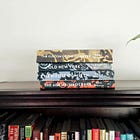The perfect alchemy of a propulsive read
What makes a book propulsive? Let's dissect the plotting, pacing, and prose of propulsive books that keep you turning the pages.
Propulsive is a fantastic marketing word. Who doesn’t want to read a book that keeps you hooked, turning the pages all night to see what happens next? I often see propulsive in blurbs for mysteries and thrillers, but this time of year I notice it pop up in book descriptions across all genres. Summer readers are looking for beach reads to grip them and not let go until vacation is over, so it’s the perfect time for us to take a closer look at how authors craft propulsive reads—and which books truly earn the propulsive descriptor.
There are many reasons I’ve stayed up past my bedtime to read a book: I love the prose, I want to stay with the characters, I am absorbed in the world. However, none of these alone make for a propulsive read.
Propulsive books sweep you through the story with powerful force and momentum. Mastery of the basics—conflict and plot—plus skilled structural design produces the most propulsive reads.
Conflict
Conflict is the underpinning of every story. It creates the friction that keeps a character from getting what they want. It cranks up the tension that ties a knot in the reader’s stomach.
You may remember learning about internal vs. external conflict1 in English class. They work in tandem to push a character to grow and change, and to keep a reader wondering “what will they do next?” or “what will happen to them?”
If you devoured Suzanne Collins’ Hunger Games series, you know great conflict. Sure, we read on to find out what the next challenge will be, but is that really what propels us to the end? Or is it about the conflict Katniss faces, having to choose between two bad options in every ethical dilemma—and balancing her personal desires with the fate of an entire country? Collins writes propulsive stories because she dances between internal and external conflict so well; nearly every scene is tense with Katniss competing against internal and external forces acting upon her.
Without conflict, there is no reason to read on.
On the other side: there’s a trend in the romance genre where authors forgo a third act break-up, or they write gentle stories with very little conflict. Some readers clamor for this kind of reading experience because hey, isn’t life fraught enough with interpersonal conflict? But I hate it. I am sorry, but those books are snoozefests! Give me a hard-earned redemption story or a how-can-they-come-back-from-that mistake any day. If you want me to keep reading, I need tension. Conflict creates tension, and tension keeps the pages turning.
Plot
I think when we say “this book has a propulsive plot” we actually mean “it is full of conflict.” Because yes, it is exciting when things happen, but it is propulsive when we care about those things happening—and the caring? That comes from characters in conflict. Emotional investment. Plot and conflict are inextricably linked—you cannot have one without the other. Even those low conflict romance novels do have some conflict because problem solving is what drives the plot forward.
Even so, there are plot devices authors deploy to keep a story interesting. Some books have excellent inciting incidents and open with a BANG, like Katniss volunteering for her sister. Or a whole space crew leaving Mark Watney behind on Mars. Or Amy Dunne’s disappearance. It’s no coincidence that all three of these examples made it big in the box office as screen adaptations. Their hooks are irresistible.
In mysteries, we encounter red herrings, whose reveals tell the reader to keep going because the case is not yet solved. In a series, or at the end of a chapter, authors utilize cliff hangers to convince readers to pick up the next book. When we get into other plot devices, like twists and flashbacks and ticking time bombs2, the further we get from what happens and the closer we get to how it is revealed.
Structure (see also: Pacing)
I believe a book can be a page-turner with sufficient attention to conflict and plot, but what takes a novel from simply entertaining to propulsive is structure—the way the story unfolds. For example: Taylor Jenkins Reid expertly hones in on structure to craft propulsive reads. I have not read Atmosphere, but I’ve heard it described as propulsive over and over since its recent release. Previously, I found Daisy Jones & the Six to be a propulsive read for a few reasons:
You know how it ends from the beginning (something causes the band to break up), so you are itching to find out what happens to tear the characters apart at the same time you are witnessing them come together. As someone who predicts a lot of plot points (a hazard of reading so many Nancy Drew novels as a child, I fear) I find this structure irresistible because it takes part of the mystery out of the equation while increasing the tension around other events. The characters keep hinting at what happened, revealing a bit more in each chapter until finally all of the details come together.
Taylor Jenkins Reid uses alternating point of view to heighten the tension even more. The interview style in Daisy Jones allows her to carefully deploy details at the right time, pulling back from the reader when the point of view switches. Down to the sentence level, she keeps the reader hooked with cliffhanger lines that run into the next chapter. Each character picks up where the other left off, a clever device to keep the reader’s brain hyper-engaged.
From what I remember, the chapters are fairly short in Daisy Jones, too. I have a hard time thinking of any propulsive reads with lengthy chapters. Shorter chapters, succinct details, and an economy of words almost physically propel a reader through the act of reading itself.3
Flashbacks work a lot like alternating POV. Just when you race up to another big reveal, an author might insert a flashback in order to slow the pace, cut you off from learning too much too soon, or reveal something to shake up what you know and keep you hooked. Flashbacks, or flash forward scenes, can also create a sense of “something is off” which always propels me forward while reading. Some examples: Never Let Me Go by Kazuo Ishiguro or The God of the Woods by Liz Moore.
It was tricky to parse conflict, plot, and structure for this exercise because the best authors balance it all so well—but for me, the secret sauce is structure. I’ve read plenty of satisfying mystery novels that carry conflict and plot well, but the most memorable up-all-night experiences belong to books with structural intrigue.
I see propulsive amply used in blurbs, summer reading guides, and book reviews. As I said—it is a fabulous marketing term. I am not here to critique its use; that’s not the purpose of this series. I am a word nerd who loves picking apart definitions, and I am a reader who values specific language in book reviews in order to build my To Be Read shelf with care.
I also find value in taking a step back from the most propulsive, fast reads to wonder how did the author do that? If you’re an aspiring writer, it’s definitely worth considering what makes a book propulsive from a craft perspective. If you’re a reader, I hope today’s exploration made you think about some of your favorite propulsive reads—and see just how tricky it was to write them.
What makes a book feel propulsive to you? Which propulsive reads do you recommend?
I would add: Long Way Down by Jason Reynolds, Passing by Nella Larsen, Bad Blood by John Carreyrou (I mostly wrote about fiction today, but the same principles apply to narrative nonfiction).
If you have a word or phrase to recommend for a future installment, please let me know! I would love to hear from you on this topic. You can send me a Substack message or leave a comment to reach me. In case you missed the first:
Some of the links in this newsletter are affiliate links. If you shop these links, I earn a small commission at no additional cost to you. Thank you for supporting my work in this way.
Internal conflict: when a character battles with problems in their head or heart. External conflict: when a character battles with outside forces like dragons, enemies, weather, social expectations.
Learn more about these plot devices.





This is so interesting to think about! I do think the device of “something happened and we go back to find out what/how” has become so overused recently. I love a propulsive read but I don’t like when the author is just dangling something to get you to turn pages, and they keep alluding to “that thing that happened!”…but they won’t say what. It’s something I started noticing in a lot of thrillers and I’ve basically stopped reading them.
This was such a helpful breakdown! I had to put a book down recently because my brain was itching for something a bit more propulsive and fast-paced.